Call today to schedule a FREE estimate!
Serving the State of Maryland and Pennsylvania
Blog #79
Making the Choice for Energy Efficiency

Making the Choice for Energy Efficiency
10/10/2023
Energy efficiency is becoming a major issue for homeowners and businesses alike. As energy costs continue to rise, it is more important than ever to make sure your home is as energy efficient as possible. One of the best ways to improve your home’s energy efficiency is to install energy-efficient windows. But with all the different types of windows available, how do you know which one is right for your home? This article will discuss the different types of windows available and which ones are best for energy efficiency.
Benefits of Energy-Efficient Windows
Lower Energy Costs
Energy-efficient windows are designed to minimize the transfer of heat between the interior and exterior of a home. By incorporating advanced technologies such as low-emissivity (Low-E) coatings, multiple panes of glass, and gas fills between the panes, these windows can significantly reduce the amount of heat that enters or escapes a home.
During hot summer months, energy-efficient windows help to keep the interior cool by reflecting a large portion of the sun's heat away from the house. This reduces the reliance on air conditioning systems, leading to lower energy consumption and subsequently lower energy bills. Similarly, during cold winter months, these windows help to retain the heat generated inside the house, preventing it from escaping through the windows. This results in reduced heating costs.
In addition to reducing energy bills, energy-efficient windows also contribute to long-term savings by reducing the demand on heating and cooling systems. By maintaining a more stable indoor temperature, these windows decrease the need for heating or cooling equipment to work harder or for longer periods of time. This not only extends the lifespan of HVAC systems but also reduces maintenance and repair costs.
Furthermore, installing energy-efficient windows may make homeowners eligible for various financial incentives. In some regions, tax credits or rebates are offered to individuals who invest in energy-efficient upgrades, including windows. These incentives aim to promote the adoption of sustainable practices and help offset the initial cost of purchasing and installing energy-efficient windows.
Improved Comfort
Energy-efficient windows are designed to effectively insulate your home and prevent heat transfer between the interior and exterior environments. By minimizing the amount of heat that escapes during colder months and reducing the heat that enters during warmer months, these windows contribute to maintaining a consistent temperature inside your home. This not only enhances your overall comfort but also helps to reduce the energy consumption of your heating and cooling systems, leading to potential cost savings on your energy bills.
In addition to their insulation properties, energy-efficient windows also provide protection against harmful ultraviolet (UV) radiation. UV rays can cause fading and damage to your furniture, flooring, and other interior elements over time. However, these windows are equipped with special coatings or glazing that can block a significant portion of the UV radiation from entering your home. By doing so, they help to preserve the quality and appearance of your furnishings, ensuring they remain vibrant and intact for longer periods.
The benefits of energy-efficient windows extend beyond temperature regulation and UV protection. These windows also contribute to noise reduction by acting as a barrier against external sounds. This can significantly enhance the tranquility and peacefulness of your living spaces, especially if you reside in a noisy neighborhood or near busy streets.
Furthermore, energy-efficient windows are environmentally friendly as they reduce the demand for energy consumption. By lowering the need for excessive heating or cooling, these windows indirectly contribute to the reduction of greenhouse gas emissions, which are a major cause of climate change. Using energy-efficient windows can be seen as a sustainable choice that helps to conserve natural resources and mitigate the negative impact on the environment.
Environmental Impact
One way to reduce your carbon footprint is by decreasing the amount of energy your home consumes. This can be achieved through various methods such as using energy-efficient appliances, insulating your home properly, and using renewable energy sources. By making these changes, you not only minimize your impact on the environment but also save money on energy bills.
In particular, energy star windows play a significant role in reducing energy consumption and improving indoor air quality. These windows are designed to minimize heat transfer, keeping your home cooler in the summer and warmer in the winter. As a result, you rely less on heating and cooling systems, which consume a considerable amount of energy.
Additionally, energy efficient windows have the added benefit of improving indoor air quality. They act as a barrier against outdoor pollutants such as dust, pollen, and smog, preventing them from entering your home. This is especially beneficial for individuals with respiratory conditions or allergies, as it helps create a healthier living environment.
Types of Energy-Efficient Windows
Double-pane windows are a type of window that consists of two layers of glass with a space in between. This space is filled with either air or a special gas, such as argon or krypton, which acts as an insulator. The presence of this insulating layer significantly enhances the energy efficiency of double-pane windows compared to single-pane windows.
The insulated glass units provided by double-pane windows helps to regulate the temperature inside a building. During the winter months, the insulating layer prevents heat from escaping through the windows, keeping the interior warm and reducing the need for excessive heating. In the summer, the same insulating layer prevents heat from entering the building, thus reducing the reliance on air conditioning and keeping the interior cool window insulation.
Low-E windows, on the other hand, are equipped with a special coating known as low-emissivity coating. This coating is applied to the glass surface and serves the purpose of reflecting infrared light. By reflecting infrared light, low-E windows are able to control the transfer of heat through the glass. In winter, the low-E coating reflects the heat back into the room, preventing it from escaping through the window. In summer, the coating reflects the heat from the sun outside, preventing it from entering the building and keeping the interior cooler.
Gas-filled windows take the concept of double-pane windows a step further. Instead of just having air between the two layers of glass, these windows are filled with a gas, typically argon or krypton. These gases have low thermal conductivity, meaning they act as excellent insulators. By filling the space between the panes with these gases, gas-filled windows provide even better insulation than standard double-pane windows. This increased insulation helps to further reduce heat transfer, improving energy efficiency and enhancing the overall thermal performance of the window.
Lastly, triple-pane windows offer the highest level of insulation among all the mentioned window types. As the name suggests, these windows consist of three layers of glass, with two insulating spaces in between. This triple-layered design significantly minimizes heat transfer, making triple-pane windows the most energy-efficient option. They are particularly beneficial in areas with extreme climates, where maintaining a comfortable indoor temperature is crucial throughout the year.
Choosing the Right Energy-Efficient Windows for Your Home
When choosing windows for your home, it is important to take into account the location and climate in which you live. Different types of windows have varying levels of effectiveness in different climates. For example, in colder climates, windows with a high insulation factor may be more beneficial in keeping the heat inside your home. On the other hand, in warmer climates, windows with a higher solar heat gain coefficient (SHGC) may be preferred to allow for more natural light while minimizing the amount of heat that enters the home.
One way to ensure that the windows you choose are energy efficient is to look for the ENERGY STAR label. This label indicates that the window meets government standards for energy efficiency. By choosing windows with the ENERGY STAR label, you can be confident that your windows are designed to save energy and reduce utility costs.
Another important factor to consider when selecting windows is the U-factor. The U-factor measures how well the window insulates and prevents heat transfer. A lower U-factor indicates that the window has better insulation properties, meaning it is more effective at keeping heat inside during cold weather and preventing heat from entering during hot weather.
In addition to the U-factor, the solar heat gain coefficient (SHGC) is another important consideration. This measurement determines how much solar radiation the window allows to pass through. A lower SHGC means that the window blocks more heat from entering your home, which can be beneficial in warmer climates or areas with a lot of direct sunlight. By selecting windows with a lower SHGC, you can reduce the amount of heat gain and potential strain on your cooling system.
Conclusion
In conclusion, investing in energy-efficient windows can provide numerous benefits, from lower energy costs to improved comfort and reduced environmental impact. By understanding how the experts choose the right one for your home, you can make an informed decision that will benefit you for years to come. At BT Windows and Doors, we provide specialized Windows and Door consultation for each home's needs - providing you with all the information needed to make the most of your renovation. Contact us today for a free consultation - we are here to improve your lifestyle.
#energy #energyefficient #saveMoney #WindowsAndDoors #window #door #WindowInstallation #DoorInstallation #Hardware #Maryland #MD
<< Prev: Simple Ways to Enhance Your Home's Curb Appeal with Window and Door Renovations, 9/19/2023
>> Next: How Energy-Efficient Windows Contribute to a Greener Planet, 10/26/2023
